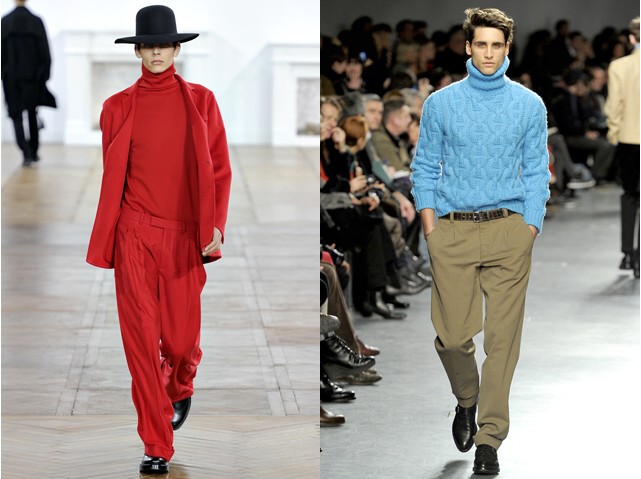
Our weekly analysis of the must-read luxury news headlines
Louis Vuitton ( L ) and Yves Saint Laurent ( R ), f/w 2011
Each January, the Paris catwalks perform an incredible ‘presto’ trick that only the chameleons of the fashion industry can witness without doing a double-take. After days spent watching men pace back and forth in comparatively utilitarian outfits, overnight, before them appear sirens and glamazons wearing the most extravagant concoctions that couture’s craftsmen can muster. Such abrupt transitions are made all the more conspicuous when the menswear shows close on a note of minimalism, as they did on Sunday.
For a fair number of the big luxury houses this fall/winter season, menswear took a minor but meaningful detour down the path of discretion, reduction and purity. And although elegant simplicity has been one of the overarching themes for a number of successive seasons, for some critics, it seemed to have finally reached a tipping point. The implication? That consumers might not be able to detect enough luxury in these luxury goods on offer.
In what she described as “those plain-looking jackets and coats closed with hook and eyes rather than showy buttons”, the New York Times’ normally pragmatic fashion critic Cathy Horyn passed judgement on designer Paul Helbers for his Amish references in the Louis Vuitton collection. “Despite some of Mr. Helbers’s knowing design details, especially in the mix of textures, the dark clothes were plain enough to make you seem invisible, one more dude in the lonely crowd," she wrote. "But if you can afford Louis Vuitton, would you want that distinction?”
“ Menswear took a minor but meaningful detour down the path of discretion, reduction and purity. ”

Dior Homme ( L ) and Hermes ( R ), f/w 2011
By contrast, a few days later when reviewing the Raf Simons show, Horyn seemed to be offering an antidote to the likes of the Louis Vuitton collection. “Am I enthusiastic about a designer whose goal is to move fashion forward?” she quipped. “You bet I am.”
Her confidence in such precariously progressive labels as Simons’s was highlighted in the undaunted tone she took as she relayed the announcement that the Belgian designer “had severed his dealings with his manufacturing partner, leaving open the question of when he will be able to sell the fall 2011 collection to store buyers” but that “small and independent designers face challenges of this kind all the time [so] he’ll just have to work it out.”
So much so did she seem to be craving something more from the Paris men’s shows, in fact, that she pronounced the flamboyant Jean Paul Gaultier “a solid collection” despite the brand’s penchant for “hamming it up” – this season, with oversized jackets and stretch pants. Not even Nicola Formichetti’s confrontational debut for the rebirth of the decadent Thierry Mugler label satiated her. "I think it might have been interesting to see clothes more directly influenced by his muse [a man dubbed “Zombie Boy” who is covered head to toe in skeletal tattoos]….."

Raf Simons ( L ) and Lanvin ( R ), f/w 2011
But of course, those luxury brands whose legacies and fortunes have been built around an unquestionably understated aesthetic or timeless designs were measured with a very different yardstick. Suzy Menkes, of the International Herald Tribune offered some subtle counsel to Yves Saint Laurent’s Stefano Pilati. “With rings on the fingers and lineups of buttons, these Saint Laurent outfits seemed to draw attention to the wearer, who would have looked more relaxed if he were trying less hard.”
For Hermès, on the other hand, “the discreet charm of whisper-quiet luxury… seems so easy in the hands of the designer Véronique Nichanian,” she extoled. “Her suits with subtle elbow pads or her pliable leather jackets are, in the famous phrase, nothing that would frighten the horses.” At Dior Homme, which under Kris Van Assche’s stewardship for the past four years has completely shed its former skin as a super-skinny rock-chic brand for provocateurs, Menkes similarly concluded that “it was the simplest pieces, like a black roll-neck sweater and low-slung pants, that gave Dior Homme an edge to its elegance.”
“ Finding that elusive balance between the directional and the classical is something that designers of menswear have struggled with for much of modern history ”
Finding that elusive balance between the directional and the classical is something that designers of menswear have struggled with for much of modern history and the deluxe end of the spectrum has been particularly challenging in this regard as it often serves a less adventurous clientele. So the designer of Lanvin’s menswear line, Lucas Ossendrijver, should have been particularly pleased to have been almost unanimously crowned a king of doing exactly that.
Besides glowing reviews from Menkes, Tim Blanks from Style.com and dozens of other influential critics for his combination of subversive tension and restrained elegance, Ossendrijver was credited by Vogue.co.uk with executing the collection “in, as you’d expect from the house of Lanvin, the most elegant of ways” while Women’s Wear Daily declared it “classic and sophisticated in allure.”

